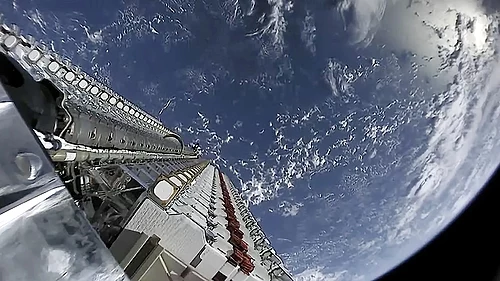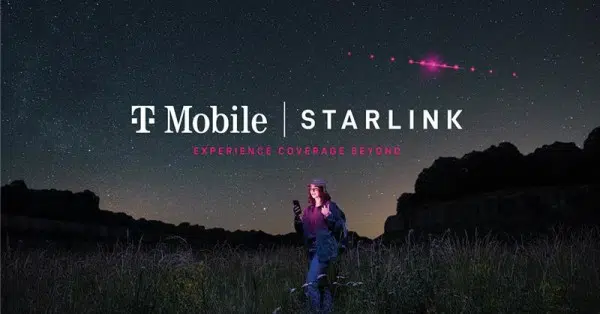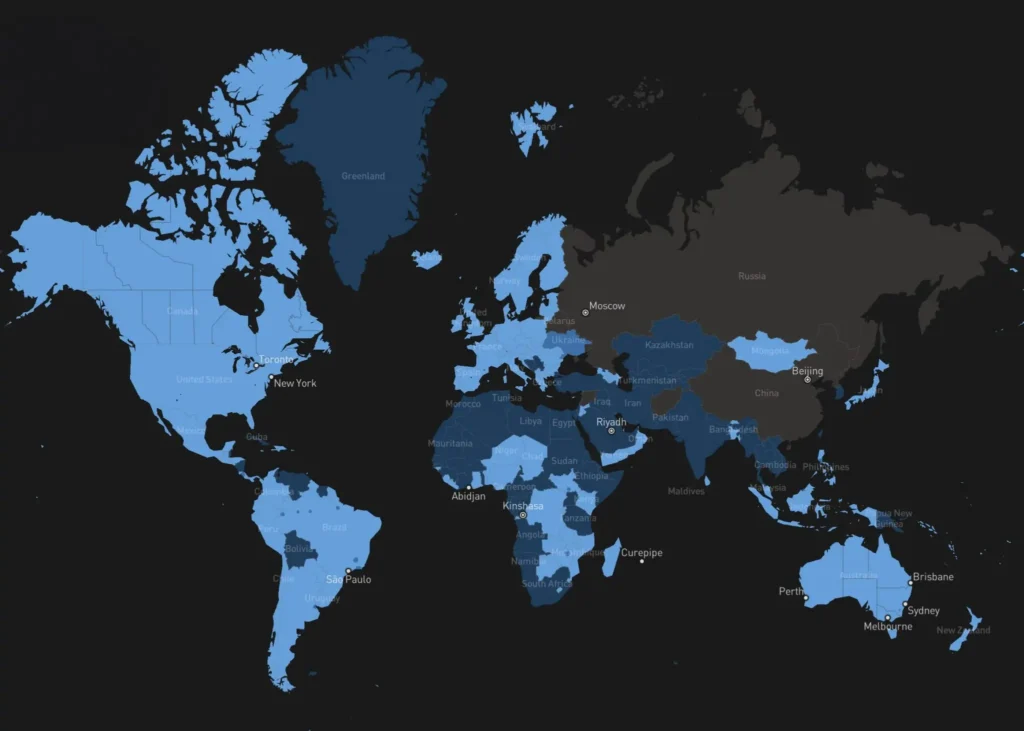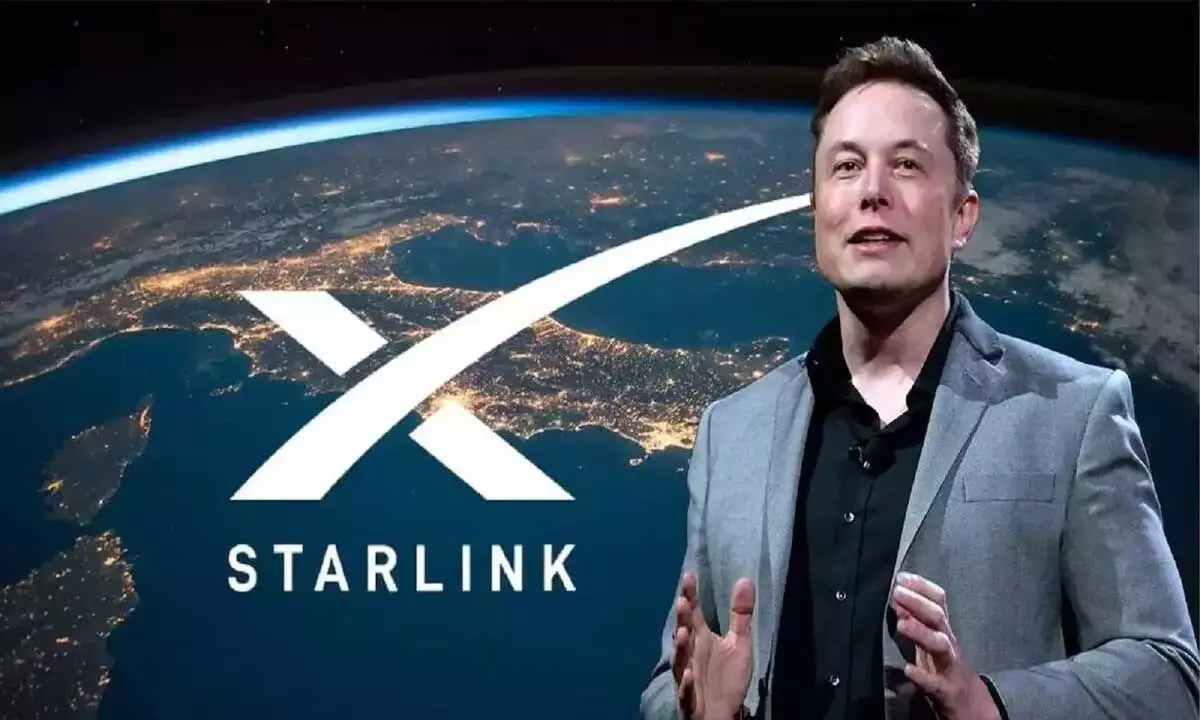Starlink has quickly become an important player within the global internet connectivity landscape, especially for rural and underserved places. This new satellite internet service, through SpaceX, utilizes satellites for high-speed low-latency broadband where terrestrial service is simply not available. As the largest satellite constellation in the world, Starlink now serves millions of active customers, significantly shaping the satellite internet market, which is projected to grow from $14.56 billion in 2025 to $33.44 billion by 2030.
This complete guide examines Starlink news and progress in 2025. You will learn how it is growing rapidly, the state-of-the-art, current position in the market, regulatory challenges outstanding, but mostly what really is the Starlink user experience for connectivity. Whether you are learning about Starlink for your rural internet service, curious how will Starlink perform or want to learn more about the new Starlink Direct to Cell service, this article will spell it all out for you.
Starlink’s Rapid Growth: More Satellites Coverage

By July 2025, the Starlink constellation is gigantic, with over 7,800 up to more than 8,000 satellites orbiting the Earth. Totaling somewhere close to 65% of active satellites in orbit, the plan is to someday reach nearly 12,000 satellites, and possibly expand in the future to 34,400.
Starlink growth
SpaceX’s ability to reuse its Falcon 9 rockets is key to this incredible pace. In 2025 alone, SpaceX has already completed 91 Falcon 9 launches, averaging more than one mission per week. This includes the significant 500th Falcon 9 launch milestone. Reusing boosters, some for their 22nd or 19th flight, drastically cuts launch costs and turnaround times. This efficiency is a major competitive advantage, allowing Starlink to expand its network and reach new regions at an unmatched speed.
Recent Starlink launches in July 2025 highlight this aggressive deployment:
- July 25, 2025: The Starlink 10-26 mission launched 28 Starlink satellites from Cape Canaveral.
- July 26, 2025: The Starlink 17-2 mission deployed 24 Starlink satellites from Vandenberg Space Force Base.
- July 18, 2025: The Starlink 17-3 mission successfully sent 24 Starlink V2 Mini satellites into a polar orbit from Vandenberg, boosting connectivity for high-latitude regions like Alaska
Starlink is strategically focusing on launching hundreds of satellites planned for polar orbits, with over 400 satellites expected to be launched in polar orbits by the end of 2025. The purpose is to more than double connectivity capacity for customers in these areas.
Here’s a quick look at recent Starlink launches:
| Date | Launch Site | Number of Satellites | Mission Name | Booster Tail Number | Booster Flight Count | Key Notes |
|---|---|---|---|---|---|---|
| July 25, 2025 | Cape Canaveral SFS | 28 | Starlink 10-26 | B1078 | 22nd | Followed global outage |
| July 26, 2025 | Vandenberg SFB (SLC-4E) | 24 | Starlink 17-2 | B1075 | 19th | |
| July 18, 2025 | Vandenberg SFB (SLC-4E) | 24 | Starlink 17-3 | B1082 | 14th | V2 Mini, Polar Orbit deployment for high latitudes |
Starlink Performance & Innovation: A Technological Edge
Starlink continues to deliver impressive performance, especially for users in remote areas, setting new standards for satellite internet.
Current Starlink Speeds and Latency

- Download Speeds : During July 2025, the median peak-hour download speed reached almost 200 Mbps in the United States.
- Starlink users : Vast majority of Starlink users received speeds between 25 and 220 Mbps, with several exceeding 100 Mbps. For businesses, the Performance Kit offered over 400 Mbps.
- Upload Speeds : Typical upload speeds are between 5 and 20 Mbps.
- Latency : Starlink has achieved a significant reduction in latency. In the US, the median latency at peak usage dropped over 30%, from 48.5ms to 33ms. The worst-case peak hour latency (p99) improved by over 60%, from over 150ms to less than 65ms . On a global level, median latency has decreased by around 25%, and worst-case latencies by around 35%. On land, expected latency is typically 25 to 60 ms.
Next-Generation Starlink Satellites
SpaceX is constantly upgrading its satellite technology for increased network capacity and reliability.
Gen 2 Authorization: Starlink received authorization for its second-generation (Gen 2) network. These next-generation spacecraft have noticeably greater throughput per satellite, which means more bandwidth and reliability for millions of new users.
Gen 3 Development: The third-generation (Gen 3) satellites are expected to launch in the first half of 2026. Designed to launch on Starship, these satellites are being designed for the provision of over one terabit of downlink capacity and enhanced uplink performance, a considerable step up for the future capabilities of the network.
Deep Dive into Starlink Direct to Cell Service
A major technological leap for Starlink is the new Direct to Cell service.

T-Mobile Partnership Launch:
The official nationwide launch of “T-Satellite”, the groundbreaking Starlink-T-Mobile satellite-to-cellphone service, February 27th, 2023 after a successful six-month beta test with nearly 2 million testers. The satellite service was essential during natural disasters, resulting in over 1 million emergency texts sent when traditional cell towers were down.
How It Works: Over 650 second-generation Starlink satellites are being launched with special payloads referred to as “cell towers in space” which are capable of connecting directly to users with unmodified 4G phones using T-Mobile’s PCS mid-band spectrum.
At launch, the T-Satellite service only supports text messaging (SMS; MMS) and emergency alerts with the goal being if a user can see the sky, they are connected, as T-Mobile believes their T-Satellite service will eliminate dead zones – all cellular companies have them.
Future Capabilities:
At some point later in 2025, T-Mobile plans to upgrade the service (as it is a new service and may require some changes) to support popular apps and data (maps, weather and social media apps). T-Mobile’s goal is also to extend coverage beyond the U.S. Ultimately, their goal is “full app connectivity without mobile coverage” anywhere a user can see the open sky.
Pricing & Accessibility: For T-Mobile subscribers, satellite texting is provided at no additional charge with eligible premium plans or $10 a month with other plans. Importantly, AT&T and Verizon subscribers can also use this Starlink-supported network for $20 per month (currently promotional rate $10), creating a “universal safety net” for mobile communication.
Regulatory Perspective: SpaceX is continuing to work with the FCC on permissions to utilize more wireless spectrum, such as the 2 GHz band, for its Direct to Cell service. The FCC has authorized the use of higher power levels for the service, over the objections of its competitors, on the condition that SpaceX must lessen any interference.
The Direct to Cell service, combined with Gen 2 and Gen 3 satellites and advanced laser links, marks a significant shift for Starlink. It moves beyond just providing internet access to enabling ubiquitous mobile connectivity, positioning Starlink as a direct competitor to traditional cellular networks. This is a massive expansion of Starlink’s market and a potential game-changer for emergency communications.
Advanced Starlink Satellite Technology
Each Starlink satellite incorporates sophisticated technology for high performance:
Optical Space Lasers (Inter-Satellite Links – ISLs): Every Starlink satellite has three optical space laser units, that can transmit data payloads at up to 200 Gbps. Optical space lasers allow satellites to form a global internet mesh, as data can then be transmitted and relayed between satellites at the speed of light in vacuum, thus reducing the dependence on ground stations and providing true global connectivity even over oceans and remote areas.
Advanced Antennas: Each satellite includes five separate advanced Ku-band phased array antennas and three separate dual-band (Ka-band and E-band) antennas capable of high-bandwidth connectivity.
Ion Propulsion Systems: Starlink uses efficient argon thrusters for precise orbital maneuvers, the ability to raise the orbit of satellites, and for active deorbiting at the end of a satellite’s life.
Starlink is the first spacecraft use of argon propulsion.
Starlink’s Commitment to Space Sustainability
SpaceX is deeply committed to maintaining a safe orbital environment. Starlink operates with the most conservative maneuver thresholds in the industry, shares high-precision orbital data, and offers a dedicated space safety service for coordination with other satellite operators. Satellites are designed to deorbit naturally within five years or less, and SpaceX proactively deorbits satellites at risk of becoming non-maneuverable, minimizing space debris.
Here’s a concise overview of Starlink’s performance and key technological advancements:
| Metric/Technology | Key Details (July 2025) | Impact/Benefit |
|---|---|---|
| Download Speed | Median US: ~200 Mbps; Typical: 25-220 Mbps; Business Performance Kit: 400+ Mbps | High-speed connectivity for streaming, gaming, business. |
| Upload Speed | Typical: 5-20 Mbps | Supports video calls, content sharing. |
| Latency | Median US: 33ms (down 30%); Worst-case US: <65ms (down 60%); On land: 25-60ms | Near-real-time responsiveness for interactive applications. |
| Gen 2 Network | Authorized; improved spacecraft with significantly more throughput per satellite | Increased bandwidth and reliability for millions more users. |
| Gen 3 Satellites | Launching H1 2026; optimized for Starship; >1 terabit downlink capacity | Massive future network capability boost. |
| Direct to Cell Service | T-Satellite (T-Mobile partnership) launched July 24, 2025; text/emergency alerts for unmodified 4G phones | Eliminates cellular dead zones, universal safety net, public safety. |
| Optical Space Lasers | 3 per satellite, up to 200 Gbps; forms global internet mesh | Reduces reliance on ground stations, enables global connectivity. |
| Argon Thrusters | Efficient electric propulsion for orbital maneuvers and deorbiting | Precise satellite control, space sustainability. |
| Space Sustainability | Conservative maneuver thresholds, public ephemerides, proactive deorbiting | Minimizes space debris, ensures safe orbital environment. |
Global Reach and Growing Starlink User Base

Starlink has achieved remarkable global reach and a rapidly expanding user base, cementing its role in the internet service market.
Expanding Starlink Coverage
Starlink has quickly expanded its global footprint, now providing Starlink coverage to 115 countries and territories as of July 2025. Recent additions include Sri Lanka and Chad. Within the United States, the constellation covers approximately 99% of the country. This extensive
Starlink availability is crucial for serving previously unserved or underserved populations worldwide.
Starlink for Gaming and High-Demand Applications
Starlink’s low latency, typically 25 to 60 ms, makes it suitable for streaming, video calls, and online gaming, a big improvement over traditional GEO satellite internet. However, for highly competitive first-person shooter (FPS) games, some users report “momentary ping spikes” during satellite handoffs and “jitter” or “desync,” which can make these specific games “unplayable outright” for some. For less latency-sensitive games, like massively multiplayer online role-playing games (MMORPGs), the experience is often described as “perfectly snappy”.
Practical Considerations and Starlink Setup Tips
Optimal Starlink performance depends on several practical factors:
Obstructions: A clear path to the sky is important for the installation to work properly. The Starlink app has a “Check for Obstructions” tool to help determine the best place for the install location. Once the installation occurs, obstructions from new tree branches, material building up on the dish, or temporary snow can still affect performance.Starlink dishes also have a built-in heating device that will help melt snow!
Setup: The Starlink setup is so easy: “PLUG IT IN” and “POINT AT SKY” and the Starlink app will find the best place to put the dish.
Service Plans and Mobility: Starlink offers a few different plans to choose from. Residential, roam, and business. Roam is if you want to connect while traveling in more than 100 markets.
Starlink Mini: It is a small, portable kit to help stay connected while traveling.
Data policy: Starlink provides generally unlimited data usage without caps or throttling. Network congestion in heavily populated regions does affect speed.
Summary of Starlink’s pros and cons based on user reviews:
| Category | Pros (Based on Reviews) | Cons (Based on Reviews) |
|---|---|---|
| Speed | “Fastest around” (234 Mbps reported); High median speeds (200 Mbps US peak). | Network congestion can affect speeds in heavily populated areas. |
| Reliability | Generally high (4.2/5 rating); “No disruption or lag” for many. | Some users report “frequent outages” and unreliability, especially for gaming/streaming; affected by obstructions/weather. |
| Customer Service | N/A | Low rating (3.2/5); “No person to speak with for support” is a common complaint. |
| Price | N/A | Considered “extremely expensive” by some users. |
| Mobility | Great for travelers, campers, boaters; “can go anywhere I want with it.” | Roam plan required for mobility, higher cost. |
| Gaming | Low latency (25-60ms) good for most games (e.g., MMORPGs). | “Momentary ping spikes” and “jitter” can make competitive FPS games unplayable for some. |
| Availability | “Great option for rural residents”; covers ~99% of US; 115+ countries. | Availability can be limited by waitlists in some areas. |
| Setup | Simple “PLUG IT IN” and “POINT AT SKY” process. | Requires clear line of sight; obstructions (trees, snow) can cause issues. |
Conclusion: Starlink’s Enduring Impact on Connectivity
Starlink is officially a leading provider in satellite internet, showing significant growth, incredible features—with respect to performance and low latency—and new features such as the Direct to Cell service. Starlink successfully connected millions to high-speed internet in areas lacking traditional services, greatly disrupting the performance of traditional internet service providers and providing an alternative where no traditional infrastructure is.
The growing investment in new internet خدمات and continuing development of its next generation satellites provides Starlink users with faster speeds and further connectivity options, with the potential to potentially remove cellular dead zones in ways that traditionally would be impossible. With its continuing push for development and further market opportunities, Starlink is likely to continue reimagining how connectivity is created.
Yet, while accomplishments are clear, Starlink has significant challenges to face. These include sustaining and ensuring network reliability as the scale continues to expand, battling complex and shifting international regulations about orbital space, and the intensifying competitive landscape from established and emerging satellite and terrestrial internet companies. Whether it is successful at surmounting these multi-faceted challenges will determine its future success and the potential lasting impression on how the world connects.
It represents a significant step toward a truly connected world and continues to challenge notions of what is possible in space and on Earth. It is an ongoing story of creativity, scale, and necessity to be flexible in addressing challenges unlike anything seen before.
Sources used in the report :
spaceflightnow.comLive coverage: SpaceX to launch 28 Starlink satellites on Falcon 9 rocket from Cape Canaveral – Spaceflight Now
starlink.comHow to fix obstructions – Starlink Help Center
reddit.comStarlink 2025. Good but not great. – Reddit
Also check out our other content and latest news
1.Starlink price in India- https://zstreamm.com/2025/07/starlink-internet-price-in-india-2025-launch-updates-plans/
2. Fantastic four first steps- https://zstreamm.com/2025/07/fantastic-four-first-steps-review/







